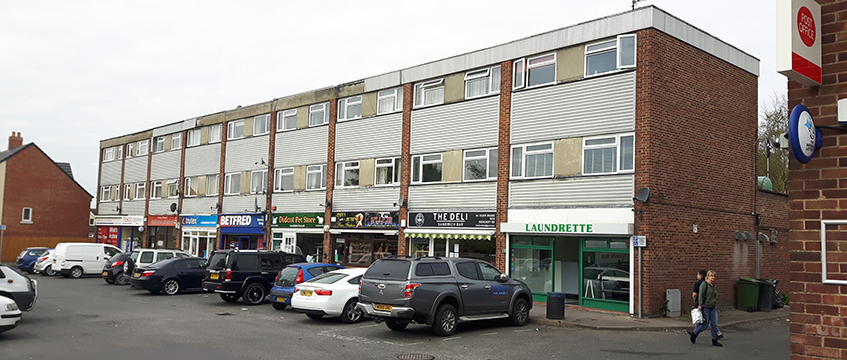Picture: A typical sub-£5m auction lot: a retail and residential investment in Didcot, Oxfordshire, sold in July for £2.1m against a guide price of £1.5m
Oliver Childs, Lambert Smith Hampton’s national head of auctions, analyses the performance of the sub-£5m commercial investment market, and unveils encouraging results that buck wider trends
Sub-£5m lots are the lifeblood of the commercial property auction market.
At LSH’s July ballroom auction, the average sale price was £350,000, but this number does not reflect the many higher-value deals that the team regularly puts together. Following the EU referendum in June 2016, the auction market remained robust. But, with some portfolio sales beginning to falter, selling off lots individually at auction became a viable alternative, as cash-rich propcos and investors looked to find a home for their money.
This may be one of the reasons why we have seen the average lot size at our auctions rise by 25% over the past three years. Of course, the asset type and location will also be relevant, but there is no doubt that with the general lack of investment opportunity in alternative markets outside the property sector, together with more complicated and higher stamp duty/land tax in the residential market, there has been no shortage of investors looking to buy correctly priced commercial assets.
Private property companies and private investors remain the main buyers of these assets in the sub-£5m sector, while overseas investors dominate the larger end of the market.
LSH has analysed the performance of the sub-£5m commercial property market to discover how the fortunes of the smaller end of the market compare with the wider market.
The key findings:
■ There is evidence of slightly contrasting fortunes in activity depending on lot size. While the wider market volume clearly peaked in 2014-15, the smaller sub £5m market has remained consistently strong.
■ Total UK volume of £25.1bn in H1 2017 was 6% below the five-year bi-annual average, while the volume for sub-£5m lot-sizes, at £0.9bn, was 3% above the five-year average.
■ Total UK volume for H1 2017 was 4% below H1 2016, while volume in the sub-£5m market was up by 6% on the same period last year.
■ H1 2017 sub-£5m was boosted by the alternative sectors, with volume up by around 50% year-on-year and on the five-year average. In contrast, office investment in H1 2017 was its lowest half-year total since 2009. Retail assets accounted for the largest proportion of sub-£5m volume, at 36%, while it accounted for only 15% of the whole market in H1 2017.
■ Private property companies and private investors are the main buyers of sub-£5m property, together accounting for 82% of volume in H1 2017. Meanwhile, overseas investors accounted for only 3% of volume, while they dominate the larger end of the market, making up 50% of plus-£5m volume.
■ Following a sustained period of yield compression, sub-£5m market average transactional yields have moved outwards over the recent months. This could be a sign that either investors are now more inclined to buy higher-risk product (say industrial) or that prices have softened for smaller secondary lot-sizes.
■ Retail has the lowest average transaction yield, at 6.52%, while offices have the highest, at 7.91%. This in is contrast to the All UK property yield, where offices perform at the lowest yield.
■ Note that IPD valuation yields have moved in for most sectors during H1 2017. The office sector is the one exception; there, yields have edged up slightly.
Comment: what’s the market doing?
Oliver Childs, LSH’s national head of auctions: “During Q1 and Q2 2017 we have seen an increase in the number of lots sold compared with last year, with our success rate remaining at a market-leading level of almost 90% – against the national average of 75%. The success rate is so important to an auctioneer, because it acts as a barometer of the market. With considered pricing and strategic marketing of each asset, a high success rate will give clients confidence that their instructions can be fulfilled. This is especially important as some clients will have a motivation to sell within a particular time scale, and any aborted or failed sale will affect their ability to achieve the best price when remarketing in the short term, not to mention any further holding costs that might become applicable.”
Simon Riggall, director and auctioneer, LSH: “We expect to see an increase in the number of local government assets being offered at auction over the next two quarters as local authorities seek to drive revenue more aggressively.”
Simon Bailey, director and auctioneer, LSH: “Twelve months on from the EU referendum, and despite this year’s snap General Election, the private investor market remains robust with an encouraging level of demand across all commercial sectors. This is fuelled largely by opportunistic buyers looking to add value either through active asset management or change of use and by the more secure income driven investors still favouring commercial property over and above alternative investment avenues.”
Mat Harris, associate director, LSH: “Many of our banking clients who have been reviewing their occupational property portfolio have benefited from strong demand where many of their assets have the potential for conversion from commercial to residential, often through permitted development rights legislation.”
Rob Hills, associate director, LSH: “Our auctions cover a mix of property assets throughout the UK. They provide our clients with a robust and transparent route to market, but the key whenever they are selling by auction is to ensure that the reserve price is set correctly from the outset. Everything else will fall in to place afterwards. No matter what the asset is or where it is advertised, if it is too expensive, it simply will not sell”.











